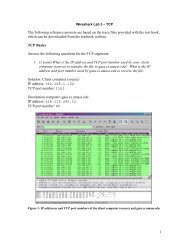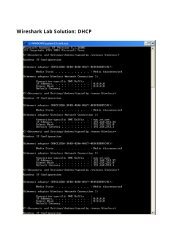Solution to Wireshark Lab: IP
Solution to Wireshark Lab: IP
Solution to Wireshark Lab: IP
Create successful ePaper yourself
Turn your PDF publications into a flip-book with our unique Google optimized e-Paper software.
<strong>Solution</strong> <strong>to</strong> <strong>Wireshark</strong> <strong>Lab</strong>: <strong>IP</strong><br />
Fig. 1 ICMP Echo Request message <strong>IP</strong> information<br />
1. What is the <strong>IP</strong> address of your computer?<br />
The <strong>IP</strong> address of my computer is 192.168.1.46<br />
2. Within the <strong>IP</strong> packet header, what is the value in the upper layer pro<strong>to</strong>col field?<br />
Within the header, the value in the upper layer pro<strong>to</strong>col field is ICMP (0x01)<br />
3. How many bytes are in the <strong>IP</strong> header? How many bytes are in the payload of the<br />
<strong>IP</strong> datagram? Explain how you determined the number of payload bytes.<br />
There are 20 bytes in the <strong>IP</strong> header, and 56 bytes <strong>to</strong>tal length, this gives 36<br />
bytes in the payload of the <strong>IP</strong> datagram.
4. Has this <strong>IP</strong> datagram been fragmented? Explain how you determined whether or<br />
not the datagram has been fragmented.<br />
The more fragments bit = 0, so the data is not fragmented.<br />
5. Which fields in the <strong>IP</strong> datagram always change from one datagram <strong>to</strong> the next<br />
within this series of ICMP messages sent by your computer?<br />
Identification, Time <strong>to</strong> live and Header checksum always change.<br />
6. Which fields stay constant? Which of the fields must stay constant? Which fields<br />
must change? Why?<br />
The fields that stay constant across the <strong>IP</strong> datagrams are:<br />
• Version (since we are using <strong>IP</strong>v4 for all packets)<br />
• header length (since these are ICMP packets)<br />
• source <strong>IP</strong> (since we are sending from the same source)<br />
• destination <strong>IP</strong> (since we are sending <strong>to</strong> the same dest)<br />
• Differentiated Services (since all packets are ICMP they use the same<br />
Type of Service class)<br />
• Upper Layer Pro<strong>to</strong>col (since these are ICMP packets)<br />
The fields that must stay constant are:<br />
• Version (since we are using <strong>IP</strong>v4 for all packets)<br />
• header length (since these are ICMP packets)<br />
• source <strong>IP</strong> (since we are sending from the same source)<br />
• destination <strong>IP</strong> (since we are sending <strong>to</strong> the same dest)<br />
• Differentiated Services (since all packets are ICMP they use the same<br />
Type of Service class)<br />
• Upper Layer Pro<strong>to</strong>col (since these are ICMP packets)<br />
The fields that must change are:<br />
• Identification(<strong>IP</strong> packets must have different ids)<br />
• Time <strong>to</strong> live (traceroute increments each subsequent packet)<br />
• Header checksum (since header changes, so must checksum)<br />
7. Describe the pattern you see in the values in the Identification field of the <strong>IP</strong><br />
datagram<br />
The pattern is that the <strong>IP</strong> header Identification fields increment with each<br />
ICMP Echo (ping) request.
Fig. 2 ICMP TTL exceeded reply, <strong>IP</strong> information<br />
8. What is the value in the Identification field and the TTL field?<br />
Identification: 30767<br />
TTL: 64<br />
9. Do these values remain unchanged for all of the ICMP TTL-exceeded replies sent<br />
<strong>to</strong> your computer by the nearest (first hop) router? Why?<br />
The identification field changes for all the ICMP TTL-exceeded replies<br />
because the identification field is a unique value. When two or more <strong>IP</strong><br />
datagrams have the same identification value, then it means that these <strong>IP</strong><br />
datagrams are fragments of a single large <strong>IP</strong> datagram.<br />
The TTL field remains unchanged because the TTL for the first hop router is<br />
always the same.
Fig. 3 ICMP Echo Request pkt size = 2000, first fragment<br />
10. Find the first ICMP Echo Request message that was sent by your computer after<br />
you changed the Packet Size in pingplotter <strong>to</strong> be 2000. Has that message been<br />
fragmented across more than one <strong>IP</strong> datagram?<br />
Yes, this packet has been fragmented across more than one <strong>IP</strong> datagram<br />
11. Print out the first fragment of the fragmented <strong>IP</strong> datagram. What information in<br />
the <strong>IP</strong> header indicates that the datagram been fragmented? What information in<br />
the <strong>IP</strong> header indicates whether this is the first fragment versus a latter fragment?<br />
How long is this <strong>IP</strong> datagram?<br />
The Flags bit for more fragments is set, indicating that the datagram has been<br />
fragmented. Since the fragment offset is 0, we know that this is the first<br />
fragment. This first datagram has a <strong>to</strong>tal length of 1500, including the<br />
header.
Fig. 4 ICMP Echo Request pkt size = 2000, second fragment<br />
12. Print out the second fragment of the fragmented <strong>IP</strong> datagram. What information in<br />
the <strong>IP</strong> header indicates that this is not the first datagram fragment? Are the more<br />
fragments? How can you tell?<br />
We can tell that this is not the first fragment, since the fragment offset is<br />
1480. It is the last fragment, since the more fragments flag is not set.<br />
13. What fields change in the <strong>IP</strong> header between the first and second fragment?<br />
The <strong>IP</strong> header fields that changed between the fragments are: <strong>to</strong>tal length,<br />
flags, fragment offset, and checksum.
Fig. 5 ICMP Echo Request pkt size = 3500, first fragment<br />
14. How many fragments were created from the original datagram?<br />
After switching <strong>to</strong> 3500, there are 3 packets created from the original<br />
datagram.<br />
15. What fields change in the <strong>IP</strong> header among the fragments?<br />
The <strong>IP</strong> header fields that changed between all of the packets are: fragment<br />
offset, and checksum. Between the first two packets and the last packet, we<br />
see a change in <strong>to</strong>tal length, and also in the flags. The first two packets have<br />
a <strong>to</strong>tal length of 1500, with the more fragments bit set <strong>to</strong> 1, and the last packet<br />
has a <strong>to</strong>tal length of 540, with the more fragments bit set <strong>to</strong> 0.





